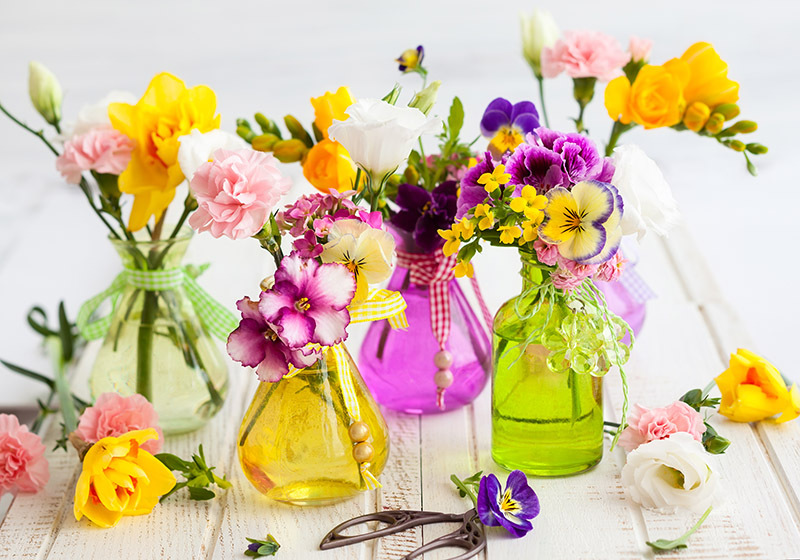Perfect Your Hydrangea Care Routine
Posted on 17/08/2025
Perfect Your Hydrangea Care Routine: The Ultimate Guide for Gorgeous Blooms
Hydrangeas enchant gardeners with their lush blooms and dazzling colors. But are you getting the best from your hydrangeas? Whether you're a beginner or a seasoned gardener, this guide is designed to help you perfect your hydrangea care routine from soil to stunning seasonal displays.
Why Hydrangeas Deserve Special Care
Hydrangeas, beloved for their voluminous flowers, come in many species--each with unique care requirements. Proper hydrangea plant care is crucial to enjoying their full potential. In this ultimate hydrangea care guide, you'll discover expert tips for vibrant, healthy plants year after year.

Understanding the Main Types of Hydrangeas
To optimize your hydrangea care routine, start by recognizing which type of hydrangea you have. The most common varieties include:
- Hydrangea macrophylla (Bigleaf hydrangea): Famous for their blue and pink mophead or lacecap blooms.
- Hydrangea paniculata: Distinguished by their cone-shaped, white to pinkish flowers.
- Hydrangea arborescens (Smooth hydrangea): Known for their tough constitution and white blossoms.
- Hydrangea quercifolia (Oakleaf hydrangea): Signature oak-like foliage and elongated flower clusters.
Knowing your hydrangea type informs everything from pruning to watering, ensuring optimum hydrangea health and blooms.
Choosing the Right Spot for Your Hydrangeas
Location is key in any successful hydrangea care routine. Hydrangeas prefer:
- Morning sun and afternoon shade (especially Bigleaf and Oakleaf types)
- Protection from harsh winds to keep blooms pristine
- Well-draining soil to prevent root rot
Tip: Panicle hydrangeas tolerate more sun and can thrive in full sun provided they get ample moisture.
Soil Preparation: The Foundation of Hydrangea Success
A thriving hydrangea routine hinges on soil quality. Hydrangeas prefer rich, loamy soil loaded with organic matter. To perfect hydrangea soil care:
- Amend heavy clay or sand with compost or well-rotted manure
- Check pH levels--especially for color-changing varieties (macrophylla)
- Ensure quick drainage to avoid waterlogged roots
Soil pH can even influence bloom color! Acidic soil (pH below 6) usually produces blue flowers, while alkaline soil (pH above 7) yields pink blossoms.
Watering Techniques for Hydrangea Happiness
The Importance of Consistent Moisture
Hydrangeas adore moisture but detest soggy soil. Key points for watering your hydrangeas the right way:
- Water deeply 1-2 times per week, more often in heatwaves
- Use mulch to retain moisture & regulate soil temperature
- Water at the base in the morning to reduce fungal risk
Quick tip: Wilting during the day can be normal if leaves recover by evening. Persistent droopiness signals the need for more water.
How and When to Fertilize Hydrangeas
A robust fertilization routine is vital for abundant hydrangea flowers and vigorous growth. For best results:
- Apply a balanced, slow-release fertilizer in spring
- Repeat lightly in early summer for bloomers that flower late (like panicles)
- Avoid over-fertilizing, which can cause lush foliage at the expense of blooms
Organic options like compost and fish emulsion also work wonders for natural hydrangea care.
Pruning Guide: Timing and Techniques
Pruning hydrangeas correctly ensures yearly displays of spectacular blooms. But not all hydrangeas are pruned the same way:
- Bigleaf and Oakleaf hydrangeas: Prune just after flowering, as they bloom on "old wood" (last year's growth). Cut back spent flowers and one-third of the oldest stems.
- Panicle and Smooth hydrangeas: Prune in late winter or very early spring, as they flower on "new wood". Cut stems to the first pair of healthy buds.
Never prune in autumn, or you risk removing next year's flower buds!
Changing Hydrangea Bloom Color: The Science Explained
A fun aspect of hydrangea care routines is the ability to influence flower color in Bigleaf varieties. Here's how:
- To turn blooms blue: Increase soil acidity with sulfur or aluminum sulfate
- To turn blooms pink: Make soil more alkaline with garden lime
Remember: White hydrangeas do not change color with soil pH.
Mulching and Weed Management
Hydrangeas benefit from a thick layer of organic mulch:
- Retains crucial moisture
- Suppresses weed growth
- Feeds the soil as it breaks down
Suitable mulches include shredded bark, leaf mold, or compost. Apply 2-3 inches around the base each spring for peak hydrangea health.
Dealing with Hydrangea Pests and Diseases
Hydrangeas are usually hardy, but every gardener should monitor for common problems:
- Powdery mildew: White, powdery leaves--improve air flow and water at the base
- Leaf spot: Remove affected leaves; avoid overhead watering
- Aphids, spider mites, and scale: Hose off or use insecticidal soap
Regular inspections will keep most issues in check. Remove debris around plants to prevent fungal problems.
Hydrangea Winter Protection and Seasonal Care
Winter planning is a vital part of your hydrangea maintenance routine. For cold climates:
- Mulch heavily around the base in late fall to insulate roots
- Wrap young or tender Bigleaf and Oakleaf hydrangeas in burlap for added protection
In spring, remove mulch gradually as temperatures rise, and refresh your hydrangea care routine for robust new growth. Panicle and Smooth hydrangeas are generally hardier and require less winter coddling.
Propagating Hydrangeas: Expand Your Garden with Ease
Want more beautiful hydrangea bushes in your landscape or to share with friends? Hydrangeas are easy to propagate via:
- Softwood cuttings: Take 6-inch tips from healthy stems in late spring or early summer, dip in rooting hormone, and pot them up
- Layering: Bend a low branch to the ground, cover with soil, and wait for new roots to form
Patience pays off--a little effort yields stunning rewards!
Common Hydrangea Care Questions Answered
Why Won't My Hydrangea Bloom?
- Improper pruning--are you cutting off flower buds?
- Too much nitrogen-heavy fertilizer
- Excessive shade
- Winter bud damage (especially Bigleaf types)
Check your hydrangea species and adjust your hydrangea care routine as needed.
Can I Grow Hydrangeas in Pots?
Absolutely! Use a large container with excellent drainage, a rich potting mix, and water regularly. Bigleaf and Smooth hydrangeas do especially well in containers.
Perfect Your Hydrangea Care Routine Year-Round
Successful hydrangea care comes down to consistency and observation. Here's a sample year-round hydrangea maintenance routine:
- Early Spring: Prune Panicle and Smooth hydrangeas; fertilize all types
- Late Spring/Early Summer: Deadhead spent blooms, propagate cuttings
- Summer: Monitor water and mulch; look for pests and diseases
- Fall: Reduce watering as plants go dormant; mulch for winter protection
- Winter: Keep roots insulated; avoid early pruning

Advanced Tips for Gorgeous, Healthy Hydrangeas
- Rotate mulch each season to prevent disease buildup
- Collect rainwater for gentle, pH-neutral irrigation
- Test soil annually and adjust pH/fertilization accordingly
- Deadhead regularly to extend blooming and tidy up shrubs
- Group hydrangeas for more impact and shared moisture
When you perfect your hydrangea care routine, you'll be rewarded with healthy, vibrant plants that steal the show each season.
Conclusion: Mastering the Art of Hydrangea Care
Learning how to care for hydrangeas is both an art and a science. By understanding your plant's needs, maintaining the right environment, and sticking to a regular hydrangea maintenance schedule, you'll enjoy show-stopping blooms for years to come.
Ready to perfect your hydrangea care routine? Grab your gardening gloves, apply these tips, and watch your hydrangeas flourish like never before!
For more hydrangea tips and tricks, bookmark this guide and revisit it every season. Happy gardening!
Latest Posts
Perfect Your Hydrangea Care Routine
Birth month flowers: Symbolism and significance explained
A Deep Dive into Red Roses for Valentine's Celebrations





